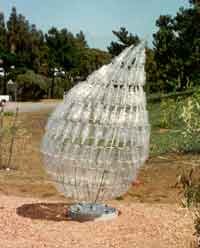My artwork is made of sheet metal, mounted with a sculptural relief of cut metal shapes and found objects. These may include salvaged automotive machine parts, plumbing pipes, fencing material, discarded utensils such as spoons, wheels, wire, toys, and old etching plates. I also include discarded garments, hats, pillows, and fabric. The objects and cut shapes are mounted onto metal, if I am working in a small scale, canvas, if I am working in a larger scale of up to 6 x 8 feet. The relief is then spray painted with automotive enamel. Finally, small areas of the assemblage are painted in a very detailed oil technique. The oil painting is delicate and surreal.
I choose to use discarded objects and materials because the materials themselves express much about contemporary life. For example, I can evoke ideas of travel, speed, and industry by incorporating a car part. I can suggest a figure by the use of a garment. The fact that the objects are used and work adds another idea to reflect on. Who wore this once? What kind of car did this part belong to? Is it broken? Or just old? The parts are fragments from real life; they are collected, often cut or otherwise modified, pieced together and given a new skin with a coat of paint. I like to use a glossy enamel automotive paint which gives the old objects and metal shapes a sensuous surface.
I combine contrasting materials in an unexpected way to create an overall surreal and fantasy appearance. The two main elements of the artwork, the painting and the assemblage, are themselves an unexpected combination. The assemblage is made of machine-made objects, some of which are parts of other machines, such as car cable. I sometimes use sheet metal that is patterned, like that found on the back of refrigerated trucks. After it is painted, the assemblage has a cool, overall slick surface, like a new car. The oil painting, in contrast, is delicate and detailed. It is often a human figure or a surreal scene with a figure, of sorts, within. The paintings are added like decals to the smooth surface of the assemblage.
My residency at Recology San Francisco has been an adventure in an Oz-like Land of the Senses. Winding paths with foreign smells lead to processing zones where machines are busy crushing or sorting. Heaps of glass and plastic sparkle with a promise of something better than the dusty warehouses and the pungent odor suggest. Outside, larger mountains are made of ragged metal, wood, paper, clothes, and unimaginable quantities of industrial and household debris.
I was a scavenger, invited to hunt through these odd mountains for treasures, looking for objects with interesting shapes and textures that I could transform into art. My treasures were pots and pans, old fans, screens, gates, bicycle parts, industrial lamps and stove tops. I once found what looked like an industrial size gynecological probe with a lantern at the end, good for exploring caves.
I found the sensory input of this adventure to be more profound than the wonderful objects. The repugnance and attraction of this OZ land are similar to the feelings I have had changing my baby’s diapers. The beauty of infant flesh and love for the baby intermingles with repugnance for the waste. I was reminded of Julia Kristeva’s words about the maternal being the “trustee of that mapping of the self’s clean and proper body …” Acting in maternal ways, the caretakers of the earth deal with what is repugnant, toxic, and disease ridden.
Photos and press release for this artist.
